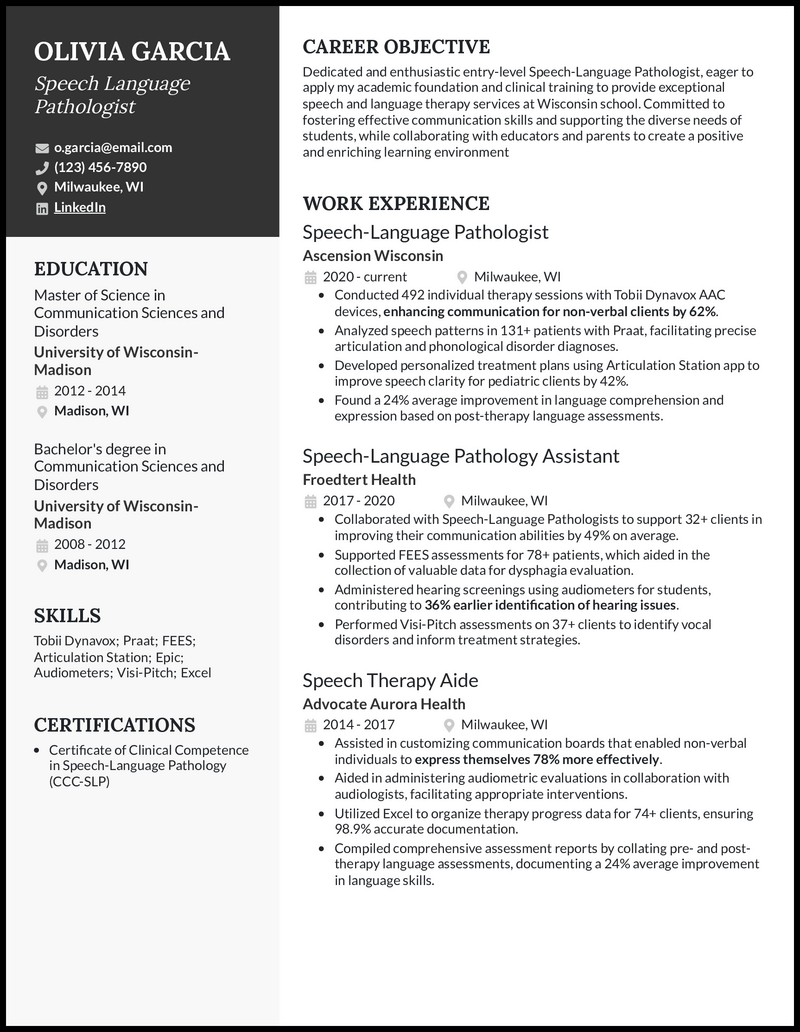

There’s plenty of room in our elegant resume template to add your professional experience while impressing recruiters with a sleek design.
Like this template? Customize this resume and make it your own with the help of our Al-powered suggestions, accent colors, and modern fonts.
When a patient’s speech, swallowing, language, or voice is affected, you’re there to diagnose them and help develop treatment plans. You also provide insight on whether speech or language therapy is necessary to help the patient communicate well.
But does your resume template help you adequately communicate your abilities so you can help others? What skills should you prioritize, and how do you stand out as unique?
No problem! We’ve helped plenty of people in your field before, and we’ve put together five speech language pathologist resume examples to help you build up some momentum before generating a cover letter.






Here’s a quick shortcut formula for you: Skills you possess + what the job description asks for = your skills list. It really is just that easy to create the first draft of your skills list, but then you’ll want to narrow things down further so that a single glance tells recruiters “Awesome speech language pathologist here”!
To hone your skills list to a compelling edge, think technically about your job: What exactly do you do during a day at work? You might use “communication skills,” but wouldn’t it be better to list “Patient Consultation” to show how you communicate with patients in a medical, digital setting?
And be specific about skills in terms of nuances alongside angling each skill in favor of your credibility as a speech language pathologist. If you have a favorite handful of software tools that get you through the day, name them.
Need some ideas?
![]()
Now, while we strongly suggest referencing the job description for inspiration while writing your own speech language pathologist resume, don’t repeat any significant portions of it! Reflecting some of their values and working their most common keywords organically into your own experience points is totally different.
Recruiters want to see that you’ve created success in this field, not just that you’ve read the job requirements and repeated them. Leverage your past achievements and accomplishments to show your diagnostic capabilities or aptitude for treatment planning and consultation.
And don’t forget two really important components: Metrics and active language!
You’ll need to provide quantifiable data to back up your stories of successful patient outcomes and improved clinic ratings. And your experiences will sound much better when you set them off with active verbs that pack a punch!
See what we’re talking about?
That depends on which of your qualification sections looks the most impressive! If your experiences in speech language pathology are incredible, put them right in the center spotlight. If you have a lot of other sections besides your skills and personal info, like “Internships” or “Awards,” try a column layout.
How do I get past the ATS?Honestly, if you’ve done enough research to formulate a solid skills section and frame your experiences according to the individual job listing, you’re probably good here. All the same, check again to make sure there aren’t any other job-related keywords to work in.
How do I know which skills to pick?Revisit the job description! Do they focus more on technical stuff like Speech Studio, or interpersonal niches like care planning and patient consultation? Reflect whatever skills they mention the most, both in your skills list and in your examples section.